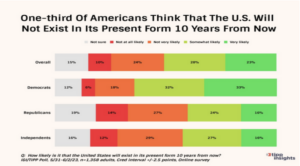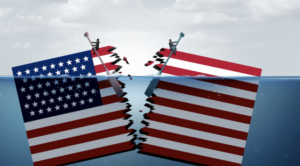According to the latest Insights and Issues/TIPP survey, Americans aren’t optimistic about the future of the United States.
We ask each month, using the Unity Index (proprietary I&I/TIPP gauge for national harmony), if people still feel a common bond. The five responses are: “very united,” “somewhat united,” “somewhat divided,” “very divided” or “unsure.”
For June’s national online I&I/TIPP poll of 1,358 adults, taken from May 31-June 2, just 24% of respondents declared that they felt the U.S. was “united.” Among that group, only 9% said the U.S. was “very united,” while 15% called it “somewhat united.”

But by nearly 3-to-1, 74% of respondents called America “divided.” Of those, 42% said it was “very divided,” while 32% termed it “somewhat divided.”
Three-fourths (or 74%) of respondents believe that the United States are no longer united. This is concerning for anyone concerned about the future. Here’s what I found most troubling:
This month’s I&I/TIPP poll asked for a bonus, perhaps to better understand Americans’ apparent anxiety about the United States as a united country. “How likely is it that the United States in its current form will still exist 10 years from now?”
It was a disconcerting response: 51% of respondents said that it was likely, while 34% thought it unlikely. Another 15% were unsure.

This should make you pause and think.
For a long time, the current divisions within the United States are a cause for concern. I am old enough to recall Watergate, the electoral fallout that followed it, and I cannot remember a time in which the country was so divided on partisan lines. What will the new North American political system look like if one-third do not believe that the United States of America will still exist in 10 years? Will the country split up and be divided along a red/blue line?
How would it work? The suburbs would be caught between a rural/urban split. Cities are the centers of modern technology, they’re also where major hospitals are located. The countryside is the source of most food, and also the place where energy is extracted and produced. Both sides seem to be quite dependent on one another.
Issues & Insights commissioned the study and have some optimism:
It is true that, as Yeats said, “Things fall apart, the center cannot hold.” America’s social climate is in turmoil, and voters are unable to agree on anything.

The nation’s founding fathers designed a flexible government system, and we have been through severe periods of social stress in the past, including mass migrations and an Industrial Revolution. We also experienced a Great Depression, a Civil War, and a Great Depression. We are still the richest and most powerful nation of all time, guided by the Constitution, which many people consider the greatest political document in history.
Will Americans give up that?
We could.
Take a look at the rhetoric coming from Washington. When things don’t work out for them, the political left in particular wants to change the rules. I&I mentions the Constitution but some call for a radical amendment or even to abolish it. This is madness.
One answer might lie in decentralization. Reduce the Federal Government’s role, and return it to the Constitutional limits. As the Constitution states, let the states take care of most governance. What works in Massachusetts will not work in Florida and what works in California will not work in Alaska. Let the states go back to their constitutionally defined roles, and shrink Washington down to the size intended by the Founders – that is to say, bring the Federal government to the 1850s. The states will be able to maintain their culture and lifestyles while still remaining a united nation for a little while, even if only on a superficial level. It may work or it may not, but it is better than tearing the country apart.










